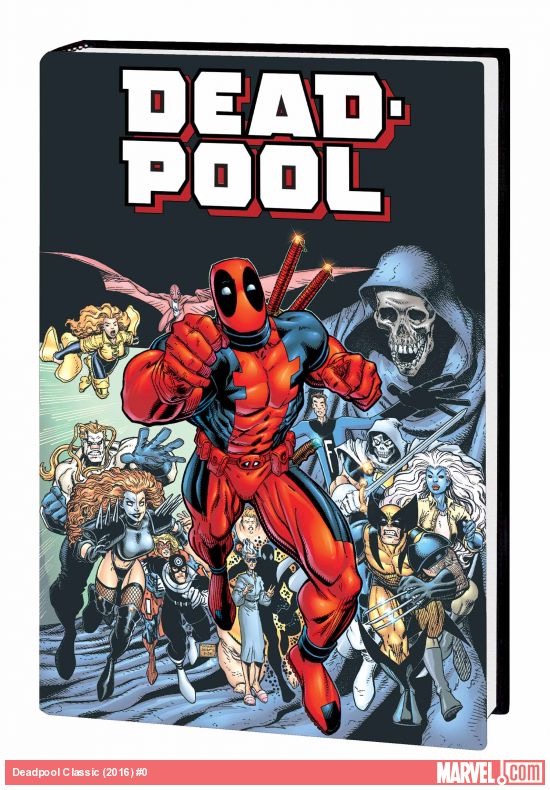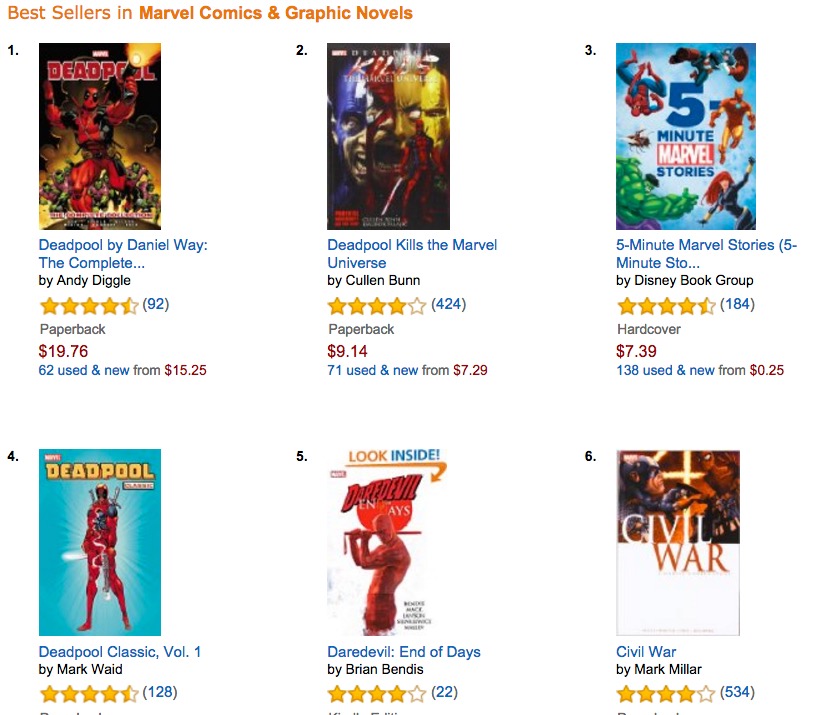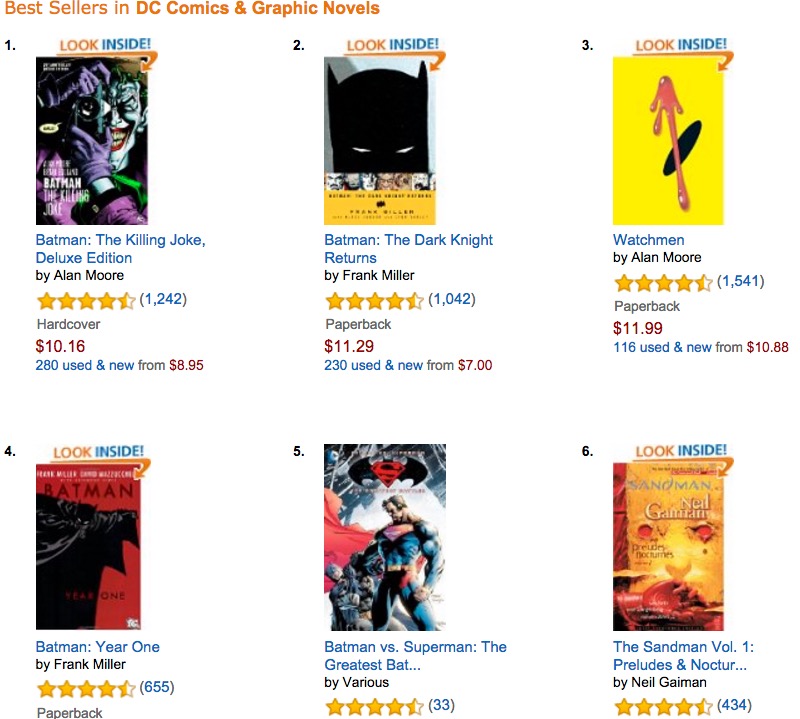Yesterday Alex Zalben had a modest proposal on CBR called For Comics to Survive, They Must Align with Movies & TV and drew a lot of fire on comics twitter. The piece starts out pointing out how DC dropped the ball by not having a Supergirl comic to come out with the Supergirl TV show but unfolds it as a tarp to cover much of the Big Two publishing strategy:
“Supergirl” isn’t the only problem here, though… When it comes to Marvel and DC’s superhero output, the problem is industry wide. There have been varying tacks taken, and different strategies, but ultimately there are two ways of addressing this issue that must be taken, or Big Two superhero comics will continue to die on the vine.
Zalben runs down all sorts of tie-in scenarios from The Walking Dead to Star Wars and back.
To narrow in even further, Marvel’s “Star Wars” is the perfect example of how to handle this sort of thing the right way. It takes place between “A New Hope” and “Empire Strikes Back,” so let’s be honest: there shouldn’t be any real tension about whether Luke, Han, Leia or even Darth Vader are going to survive. But Marvel has given the reins to top-tier writers and artists, and allowed them to tell epic stories in the Star Wars galaxy that feel as vital as the movies themselves. Heck, “Darth Vader” is the most grippingly tense comic currently on the market, and he shows up for at least another two movies after this, so I know he’s going to be fine.
It comes down to the writing, the art, and the freedom to explore that make these licensed properties non-boring.
TBH, I don’t have much beef with the piece except for the click-bait-y title, which I just piggybacked on so pot/kettle. If it has just been called “Comics Must Align with Movies & TV” it would have been stating a simple fact and not gotten as much attention.
As I’m fond of saying, comics will survive no matter what, and an infinite number of Agents of S.H.I.E.L.D. comics might actually hasten the demise of the existing retail system.
But of course, comics could do a better job of tying in with their media extensions; Supergirl is the most obvious example of that. At he recent Toy Fair here in New York, the typical tie-in rollout that rules most merchandise was on plain view. It’s just kinda simple common sense that when a big tentpole of some kind arrives you roll out your tie-ins. Novelizations come out when just before the movie (Unless it’s Star Wars) and not six months later. Hot iron = time to strike! Comics have often floundered with this simple formula.
However since a greater and greater percentage of our film and TV media is based on comics properties, publishers have had a lot of time to see what works and what doesn’t. Back when the superhero movie juggernaut go off the ground with Spider-Man and the X-Men films, there was a negligible impact on sales, and Marvel acted accordingly. (Somewhere in my digital photo archives is a picture of a big display of Spider-man merchandise that no one was buying at a Virgin Records, but I think the death spiral in that particular scenario is self-evident.)
Since then, something one might call the “Sin City Doctrine” has been borne out time and time again: comics tie-ins work best when the relationship between the movie/TV show is close and to clear that no one can miss it—and the comic is good on its own merits. The Walking Dead’s staggering sales are a clear example. Watchmen sold a million copies. More recently, Hellblazer trades got a boost when the TV show was announced. The surge in Deadpool sales is another more recent example that shows what works and what doesn’t.
I wrote about this all the way back in 2005. SIn City, 300 and Hellboy were all huge hits for Dark Horse when the films came out, sometimes so much so that they couldn’t get books in from China fast enough. While X-men, Spider-Man and even Batman didn’t climb the charts, this clear-cut source material (all of high quality, even if problematic) was an easy sell.
Deadpool trades selling so well now illustrates a lot about how the comics/movie synergy has changed since Spider-Man. First, Deadpool is a character whose popularity soared during an era when comics readers were more self-identified; if you’re a Deadpool fan the comics are an integral part of what makes the character cool, not just awkward source material for a Saturday morning cartoon. Second, Marvel obviously got a lot smarter about how to market this stuff, and has been able to keep the key books in print (not always something they did). While there is no “definitive” Deadpool comic, the Daniel Way and Deadpool Kills the Marvel Universe books are very similar to the film’s tone and moviegoers who decide this is a good “jumping on” point won’t be disappointed.
I’m not sure Supergirl, as presented in either the comics or the TV show, has the same appeal or mythology. In 2016, the pop culture consumer had a literally endless supply of material to keep them busy: comics, books, tv shows, video games, toys, think pieces on the comics, books, video games and toys, interview with people who make the toys, etc. etc etc etc. It’s not like the time when licensing was invented and people loved the Superman comics so much they ran out to watch movie serials and cartoons and there was nothing else to do.
That said, this seems like low hanging fruit in many cases. Not having a Supergirl comic or trade or something out seems like poor marketing. If you look at DC’s top sellers on Amazon a media-tie in angle is evident in many of them.
It’s the usual suspects, but some Batman v Superman tie-in items are creeping in. People like Batman! People like Alan Moore and Frank Miller! Frances Manapul’s Flash collection is also selling well, and I’d have to imagine that has something to with the TV show. I’m sure we’ll see a judiciously curated roll-out of Suicide Squad collections over the next few months; if THAT doesn’t work, you’ll know something is seriously wrong at DC AND Random House, and I don’t expect to see that.
So to give my own take on the Sin City Doctrine:
1. Strong source material always sells. The original Civil War trade has been a consistent bestseller for Marvel since it came out. As the movie hits, a consistent backlist star will become a super star.
2. The closer the adaptation sticks to the source material the more it will sell. i.e. Sin City, 300, The Walking Dead.
3. Media tie-ins that expand on a popular universe are now accepted as canon or near canon, and will attract a portion of the fanbase. I.e. Star Wars, Adventure Time, Buffy, The X-Files, etc.
4. Putting out a cheap digital tie-in is a good way to stay relevant when none of these three situations exist, IE the just announced Caredevil/Punisher crossover comic.
Pop culture just isn’t as siloed as it was when the Superman movie serial came out, or even the first X-Men movie. Marketing strategies need to be multi platform. If not a single media-crossover comic was published from this day hence the industry would survive in a different form, but as long as its a sound publishing strategy, we should let let publishers and retailers make money from this channel.







I think you make a good point Heidi with any Supergirl material currently available not necessarily being easily associated with the show currently on television. I think DC had a similar issue with Green Arrow in that the Year One comic by Andy Diggle and Jock was the closest in tone to what they were trying with the show, but outside that (and the show being more a Batman clone in it’s first year than anything else) it was incredibly hard to try to cross-promote it with anything.
DC started reprinting the Ostrander Suicide Squad book in trades last summer, and by the time the movie comes out (much like Marvel did recently with Jessica Jones) most of the run will be available, essential considering the characters and tone of the movie looks to be closer to that book than anything DC is currently publishing relating to the Squad.
So I think Marvel and DC are getting better at it, but there will always be growing pains to be had.
Tie-ins can work, but the huge hurdle is the direct market problem. The average person doesn’t have a comic shop near them and if they do they aren’t aware of it. You’re not driving 10-2o miles to buy a comic book for yourself or your kid because you like a TV show (just to find out you were supposed to pre-order the comic 6 weeks before the show premiered so you leave empty handed)
The LCS/Direct market system works well, but it shouldn’t be the only way to reach new customers ESPECIALLY when you’re trying to do cross over and tie-in stuff. You need to make it easy and accessible, not elitist and complicated.
If they did some sort of “Amazon Exclusive” arrangement for tie-in books and promoted the crap out of it, well then you’d have some legs with it. But retailers would complain way to loudly to ever let the comics industry try a mild innovation like that.
You know the interesting part is that when comics do things like change the ethnicity of Nick Fury after all this time he spent in the Marvel Universe, it still doesn’t rub me the right was as a fan. I think it might be because of how the character was introduced so quickly, like these changes in the comics influenced by TV and movies aren’t properly seeded or introduced. It’s an interesting thing to think about.
Let’s be sure to define our terms here, though. TV shows/movies might make an existing comic book reader more interested in reading books that feature the characters from that TV show or movie, but a very tiny percentage of the overall TV/movie audience is going to be someone who actually reads for pleasure, much less someone who would seek out more of that content to read.
And if the audience already understands comics, I would think they would understand the differences between the comics and TV/movie.
Caredevil/Punisher? My only question is how this could possibly not be a comic already.
Caredevil: The Man with a Big Heart
I think it’s well and good to have high quality, TPB ready stuff ready to go to cross-promote movies and TV. But there’s zero reason to change up continuity to better match tv or movies. The tail shouldn’t wag the dog. Obviously Hollywood saw something in the comics that was worthwhile. No other medium does this sort of pandering. When Harry Potter movies started making millions, did JK Rowling go back and change Harry’s eye color to match Dan Radcliffe’s?
FWIW, the guy who wrote “Jumper” wrote a sequel to the book that implemented the changes they made for the movie…
Comments are closed.